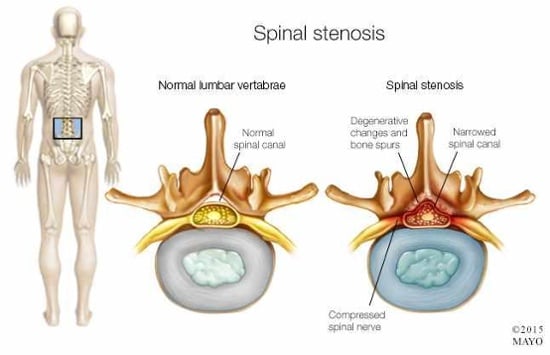
What is Spinal Stenosis?
Spinal Stenosis is one of the most common conditions that causes lower back pain and lower extremity (leg) pain in older adults. Stenosis means narrowing in the spaces within your spine which can lead to compression of the spinal cord and nerves/vascular structures exiting your spine. Such compression of these nerves in the lower back can result in back and leg symptoms.
What causes Spinal Stenosis?
There are many factors leading to spinal stenosis including: osteoarthritis (wear and tear of the joints), narrow spinal canal, tumor in the spine, past spinal surgery, and rheumatoid arthritis.
What are the Symptoms?
Nerve compression may cause back and leg pain/symptoms including:
- Numbness and tingling of leg or foot
- Loss of sensation in the foot
- Leg cramping and weakness
- Pain usually worsens with standing and walking, and lessens with bending or leaning forward.
- Loss of sexual ability
In severe cases, one may have trouble with bowel and bladder management which requires immediate medical attention.
Who is at risk?
Spinal stenosis is most common in adults over the age of 50.
How is spinal stenosis diagnosed?
After a complete medical history and physical examination completed by your doctor, other imaging tests may be ordered such as X-rays and MRI. X-ray visualizes bones and determines if there are bone spurs (extra bone growth) pushing on the spinal nerves. An MRI is more detailed than X-ray, as it visualizes soft tissue including muscles, nerves, discs, and the spinal cord.
What treatment options are available?
Non-surgical treatment options…
There are many non-surgical treatment options that can help decrease your pain and symptoms including:
Physical Therapy: Your physical therapist will design a treatment program to help you decrease the pain and symptoms, improve your mobility and strength, improve your endurance and your balance.
This treatment program may include:
Hands-on techniques such as soft tissue massage and joint mobilization
Stretching and strengthening exercises of your leg muscles, core, and back
Aquatic therapy
Home exercise program
Other treatment modalities may include: cupping, electrical stimulation, inversion table, and mechanical traction.
Steroid injections
Another treatment option aimed to decrease the inflammation and swelling of the nerve where it’s being pinched is through injecting a steroid medication into the space of the compression. It doesn’t cure spinal stenosis but it can help decrease the pain caused by the compressed nerve. However, it doesn’t work for everyone and repeated injection treatment may weaken the surrounding tissue.
Surgical treatment
If all other treatments fail to decrease your pain and symptoms or if your symptoms have greatly limited your ability to perform normal daily activities, you may want to consider surgery. There are many surgical options available and your surgeon will determine the best surgical option. Research shows less complications may result after surgery if done by a highly experienced surgeon. Therefore, make sure to ask about your surgeon’s experience and always get a second opinion to avoid possible complications.
Are you experiencing low back pain or suspect you might have spinal stenosis? Schedule an appointment with one of our therapists using the form below.

